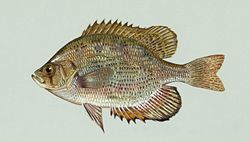Sunfish
| Sunfishes | ||||||||||
|---|---|---|---|---|---|---|---|---|---|---|
 Flier (Centrarchus macropterus)
| ||||||||||
| Scientific classification | ||||||||||
| ||||||||||
 Sunfish range
| ||||||||||
|
Acantharchus |
Sunfish is the common name for the freshwater, ray-finned fish comprising the North American family Centrarchidae of the Perciformes order, characterized by a laterally compressed body and dorsal fins typically with 5 to 13 spines. This family includes such familiar species as the black basses, rock bass, largemouth bass, bluegill, and crappies.
Some other fish, both marine and freshwater, also have the common name sunfish. These include the marine family Molidae, which are sometimes known as "marine sunfishes," and such saltwater fish as the "ocean sunfish" (Mola mola), "oblong sunfish" (Ranzania laevis) and the "moonfish, "sunfish" or "opah" comprising the small family Lampridae of two species. Another group of freshwater fish sometimes known as sunfish that are not part of the Centrarchidae family include the "pygmy sunfish," which compise the genus Elassoma of family Elassomatidae.
Overview
of freshwater ray-finned fish belonging to the order Perciformes. The type genus is Centrarchus (consisting solely of the flier, C. macropterus). The family's 27 species includes many fishes familiar to North Americans, including the black basses, rock bass, largemouth bass, bluegill, and crappies. All are native only to North America.
Family members are distinguished by having at least three anal spines. The dorsal spines are 5–13 in number, but most species have 10–12. The pseudobranch is small and concealed. Sizes of most are in the 20–30 cm (8–12 in) range, but with the largemouth bass reported to reach almost one metre (just over three feet) in extreme cases.
The male of most species builds a nest by hollowing out a depression using his tail, then guards the eggs.
Most sunfishes are valued for sports fishing, and have been introduced in many areas outside their original ranges, sometimes becoming pests.
Nelson (1994) recognizes eight genera and 29 species in Centrarchidae. The Micropterus are known as the basses (Nelson 1994), although five other genera also include representatives with the common name of bass (Agbayani 2006): Ambloplites (A. ariommus or shadow bass, A. cavifrons or roanoke bass, A. constellatus or ozark bass, and A. rupestris or rock bass); Centrarchus (C. macropterus or bass pawik); Lepomis (L. gibbosus or sun bass); Enneacanthus (E. chaetodon or bassek tarczowy, and E. gloriosus or bassek diamentowy), and Pomoxis (P. annularis or calicos bass, and P. nigromaculatus, know variously as calico bass, grass bass, oswego bass, speckled bass, and strawberry bass).
Classification
Recent genetic evidence suggests the following phylogeny of the centrarchid genera:[1]
- family Centrarchidae
- subfamily Centrarchinae
- tribe Ambloplitini
- Ambloplites
- tribe Archoplitini
- Archoplites
- Pomoxis
- tribe Centrarchini
- Centrarchus
- tribe Enneacanthini
- Enneacanthus
- tribe Ambloplitini
- subfamily Lepominae
- tribe Lepomini
- Lepomis
- tribe Lepomini
- incertae sedis
- Micropterus
- Acantharchus
- subfamily Centrarchinae
ReferencesISBN links support NWE through referral fees
- ↑ Roe, Kevin J., Phillip M. Harris, and Richard L. Mayden (2002). Phylogenetic Relationships of the Genera of North American Sunfishes and Basses (Percoidei: Centrarchidae) as Evidenced by the Mitochondrial Cytochrome b Gene. Copeia 2002 (4): 897‒905.
- "Centrarchidae". FishBase. Ed. Ranier Froese and Daniel Pauly. October 2004 version. N.p.: FishBase, 2004.
- Centrarchidae (TSN 168093). Integrated Taxonomic Information System. Accessed on 5 December 2004.
- German Website about Sunfishes and Basses www.sonnenbarsche.info
- Ambloplites rupestris1.jpg
Ambloplites rupestris
Credits
New World Encyclopedia writers and editors rewrote and completed the Wikipedia article in accordance with New World Encyclopedia standards. This article abides by terms of the Creative Commons CC-by-sa 3.0 License (CC-by-sa), which may be used and disseminated with proper attribution. Credit is due under the terms of this license that can reference both the New World Encyclopedia contributors and the selfless volunteer contributors of the Wikimedia Foundation. To cite this article click here for a list of acceptable citing formats.The history of earlier contributions by wikipedians is accessible to researchers here:
The history of this article since it was imported to New World Encyclopedia:
Note: Some restrictions may apply to use of individual images which are separately licensed.

